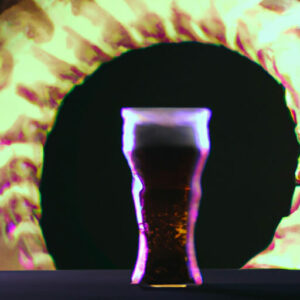If you’re a fan of Guinness, have you ever wondered how much alcohol is in Guinness? While it might depend on the type of beer that you’re drinking, there are certain guidelines for what to expect when it comes to the amount of alcohol by volume (ABV) or alcohol content contained in each glass. Understanding ABV can help make informed and responsible drinking decisions while still enjoying your favorite stout or lager. In this article, we’ll explore just how much alcohol is in Guinness – from their legendary classic ales to their newer releases. Read on to find out more!
Historical Background of Guinness beer
Contents
- 1 Historical Background of Guinness beer
- 2 Changes in Alcohol Content Over Time
- 3 Reasons for Changes in Alcohol Content
- 4 Alcohol Content in Guinness Beer
- 5 Typical Alcohol Content in Guinness Variants and Styles
- 6 Variations in Alcohol Content by Region/Country
- 7 Factors Affecting Guinness Alcohol Content
- 8 Type of Malt
- 9 Brewing Process
- 10 Storage and Serving Temperatures
- 11 Nutritional Facts About Alcohol Content in Guinness
- 12 Health Considerations When Drinking Guinness Beer
- 13 Popularity of Guinness Beer Around the World
- 14 Myths and Misconceptions of Guinness beer
- 15 How to Store Leftover Guinness Beer Without Losing Alcohol?
- 16 Natural Ways To Reduce Alcohol Level After Drinking Guinness
- 17 Conclusion: How much Alcohol is in Guinness
- 18 FAQs about Guinness Alcohol Content
- 19 What is the alcohol content of Guinness beer?
- 20 How does the alcohol content of Guinness compare to other beers?
- 21 What factors affect the alcohol content of Guinness?
- 22 Does the alcohol content of Guinness vary by region?
- 23 How much Guinness can I safely consume without exceeding the recommended alcohol limit?
- 24 How long does it take for the alcohol in Guinness to enter the bloodstream?
- 25 Is Guinness a good choice for people who are watching their alcohol intake?
- 26 How does the alcohol content of Guinness affect the taste of the beer?
- 27 Can the alcohol content of Guinness be measured using a breathalyzer?
- 28 Is Guinness more or less likely to cause a hangover compared to other types of beer?
- 29 Can drinking Guinness in moderation have health benefits?
- 30 How does the alcohol content of Guinness compare to other alcoholic beverages?

Guinness beer has a rich and storied history that dates back over two centuries. The brand was founded in 1759 by Arthur Guinness in Dublin, Ireland, and quickly became one of the most recognizable beer brands in the world.
The early years of Guinness were marked by innovation and experimentation. Arthur Guinness was a master brewer who developed several unique techniques for brewing and storing beer that helped distinguish Guinness from other brands. For example, he used a roasting process for the malted barley that gave the beer its signature dark color and robust flavor.
Over time, Guinness became known for its distinctive taste and high quality, and the brand began to expand beyond Ireland. In the 19th century, Guinness opened a new brewery in London and began exporting its beer to other countries, including the United States.
Changes in Alcohol Content Over Time
The alcohol content in Guinness has changed over the years, reflecting changes in consumer tastes and brewing techniques. In the early days of the brand, Guinness had a relatively low alcohol content of around 3-4% ABV. This was in line with other beers of the time, which were generally lower in alcohol content than modern beers.
In the late 19th century, however, Guinness began to increase the alcohol content in its beer to better compete with other brands. By the early 20th century, Guinness Extra Stout had an alcohol content of around 5.5% ABV, which was relatively high for the time.
In the mid-20th century, Guinness introduced a new beer called Guinness Foreign Extra Stout, which had an even higher alcohol content of around 7.5% ABV. This beer was designed for export markets and was brewed with extra hops and malt to help preserve it during long sea voyages.
In recent years, Guinness has introduced several new beers with different alcohol contents, including a low-alcohol version called Guinness Zero, and a higher-alcohol version called Guinness Imperial Stout.
Reasons for Changes in Alcohol Content
The changes in alcohol content in Guinness over time have been driven by several factors. One factor is changing consumer preferences, with some consumers preferring beers with higher or lower alcohol content. Another factor is competition from other beer brands, which has led Guinness to adjust its own alcohol content to stay competitive.
Changes in brewing techniques and ingredient availability have also influenced the alcohol content in Guinness. For example, improvements in yeast strains and fermentation techniques have made it easier to produce higher-alcohol beers. Conversely, shortages of certain ingredients, such as hops during World War II, led to lower-alcohol beers.
Alcohol Content in Guinness Beer

Guinness is known for its distinctive taste and dark color, but how much alcohol does it contain? The answer varies depending on the specific style of Guinness beer, as well as the region or country where it is brewed.
Typical Alcohol Content in Guinness Variants and Styles
- Guinness Draught: This is the most popular type of Guinness beer, known for its smooth and creamy texture. It has an alcohol content of around 4.2 to 4.3 percent by volume.
- Guinness Extra Stout: This type of Guinness beer has a stronger flavor and a higher alcohol content, with around 5.6 percent alcohol by volume.
- Guinness Foreign Extra Stout: This type of Guinness beer is brewed with extra hops and has a higher alcohol content than Guinness Draught, with around 7.5 percent alcohol by volume.
- Guinness Nitro IPA: This is a newer offering from Guinness, which is brewed with a blend of hops and has a citrusy flavor. It has an alcohol content of around 5.8 percent by volume.
- Guinness Blonde American Lager: This is a lighter and crisper beer than the traditional Guinness offerings, with an alcohol content of around 5 percent by volume.
Variations in Alcohol Content by Region/Country
- The alcohol content in Guinness can also vary depending on the region or country where it is brewed. For example, in Ireland and the UK, Guinness Draught typically has an alcohol content of around 4.2% ABV, while in the United States, the alcohol content is slightly higher, at around 4.3% ABV.
- In some countries, such as Nigeria and Cameroon, Guinness Foreign Extra Stout has an even higher alcohol content than in other regions, at around 8% ABV. This is due to local preferences and market conditions in those regions.
Factors Affecting Guinness Alcohol Content
The alcohol content in Guinness beer can be affected by several factors that are involved in the brewing process. Some of these factors include:
Type of Malt
The type of malt used in brewing Guinness beer plays a significant role in determining its alcohol content. The malted barley used in Guinness is roasted to a high degree, which contributes to its unique flavor and dark color. However, the roasting process can also reduce the amount of fermentable sugars in the malt. As a result, less sugar is available to be converted into alcohol during the fermentation process, which can lead to a lower alcohol content in the finished beer.
Brewing Process
The brewing process for Guinness beer involves several stages, including mashing, boiling, fermentation, and aging. The length of the fermentation process, the type of yeast used, and the temperature at which the beer is brewed can all influence the final alcohol content.
The length of the fermentation process is a critical factor in determining the alcohol content in Guinness beer. During fermentation, yeast converts the sugars in the malt into alcohol and carbon dioxide. The longer the fermentation process, the more time the yeast has to convert the sugar into alcohol, which can result in a higher alcohol content in the finished beer.
The type of yeast used in brewing also plays a significant role in determining the alcohol content. Different strains of yeast have different alcohol tolerances, meaning they can only convert a certain amount of sugar into alcohol before they become inactive. Yeast strains that have a higher alcohol tolerance can convert more sugar into alcohol, resulting in a higher alcohol content in the finished beer.
The temperature at which the beer is brewed can also affect the alcohol content. Higher brewing temperatures can cause more of the sugars in the malt to be converted into alcohol, resulting in a higher alcohol content in the finished beer.
Storage and Serving Temperatures
Storage and serving temperatures can also affect the alcohol content in Guinness beer. When beer is stored at high temperatures, the alcohol can evaporate, leading to a lower alcohol content. Similarly, when beer is served too cold, the alcohol content may be less noticeable due to the numbing effect of the cold on the taste buds.
Nutritional Facts About Alcohol Content in Guinness
- A 12-ounce serving of Guinness beer contains approximately 125 calories.
- The beer is relatively low in alcohol content, with around 4.2 to 4.3 percent alcohol by volume.
- Guinness beer is not a significant source of nutrients and is relatively high in carbohydrates, with approximately 10 grams per serving.
- The beer is also relatively low in sodium, with only 10 milligrams per serving.
- While Guinness beer is not a significant source of vitamins or minerals, it does contain trace amounts of iron, with approximately 0.3 milligrams per serving.
It is important to note that excessive alcohol consumption can have negative health effects, and that drinking responsibly and in moderation is key to minimizing the potential risks associated with alcohol consumption. It is also important to consult with a healthcare professional to determine what is right for your individual needs and lifestyle.
Health Considerations When Drinking Guinness Beer

While Guinness beer is enjoyed by many, it is important to consider the potential health effects of consuming alcohol. Here are some health considerations to keep in mind:
Alcohol Content
The alcohol content in Guinness beer is relatively low compared to other beers and alcoholic beverages. However, it is still important to drink responsibly and in moderation. The Centers for Disease Control and Prevention (CDC) defines moderate drinking as up to one drink per day for women and up to two drinks per day for men.
Calories and Nutrition
Guinness beer is not a significant source of nutrients and is relatively high in calories. A standard 12-ounce serving of Guinness contains approximately 125 calories. Additionally, the beer is relatively high in carbohydrates, with approximately 10 grams per serving.
Potential Health Benefits
While excessive alcohol consumption can have negative health effects, moderate drinking has been linked to several potential health benefits. These benefits include a reduced risk of heart disease, stroke, and type 2 diabetes. However, it is important to note that these benefits are only associated with moderate drinking and do not outweigh the potential risks of excessive alcohol consumption.
Risks of Excessive Drinking
Excessive drinking can have numerous negative health effects, including liver disease, cancer, and alcohol addiction. It is important to drink responsibly and to seek help if you have concerns about your alcohol consumption.
Popularity of Guinness Beer Around the World
Guinness beer is one of the most iconic and recognizable beer brands in the world, with a long history and a distinctive taste. The beer is brewed in Ireland and is distributed internationally, with fans all around the world. Here are some key facts about the popularity of Guinness beer:
- Ireland: Guinness is the national beer of Ireland and is a source of national pride. It is a staple of Irish pubs and is enjoyed by locals and tourists alike.
- United Kingdom: Guinness is a popular beer in the UK, particularly in cities with a strong Irish heritage such as London and Manchester.
- United States: Guinness is a well-known and well-loved beer in the US, where it is widely available in bars and restaurants. The beer is particularly popular among Irish Americans.
- Africa: Guinness is a popular beer in many African countries, where it has been brewed and distributed since the early 20th century. Nigeria is the largest market for Guinness in Africa.
- Asia: Guinness has gained popularity in many Asian countries in recent years, including Japan, China, and South Korea. The beer is often marketed as a premium import and is enjoyed by a growing number of beer enthusiasts.
Overall, Guinness beer has a loyal following around the world and is recognized as one of the most iconic and distinctive beer brands. Its popularity is a testament to the quality and flavor of the beer, as well as to the brand’s rich history and cultural significance.
Myths and Misconceptions of Guinness beer
As one of the most iconic beers in the world, Guinness has garnered a number of myths and misconceptions over the years. Here are some common myths and misconceptions about Guinness beer:
Guinness is high in alcohol content
While Guinness beer has a rich and complex flavor, it is not particularly high in alcohol content compared to other beers. As we discussed earlier, the alcohol content of Guinness beer is around 4.2 to 4.3 percent by volume, which is relatively low compared to many other beers.
Guinness is only meant to be served cold
While many people enjoy drinking Guinness beer cold, it is not necessary for the beer to be served at low temperatures. In fact, some beer enthusiasts prefer to serve Guinness at slightly warmer temperatures to better appreciate its complex flavor profile.
Guinness is only meant to be consumed in Ireland
While Guinness is a famous Irish beer, it is enjoyed by people all around the world. The beer is brewed and distributed internationally, and is available in many different countries.
Guinness is a meal in a glass
While Guinness is a flavorful and satisfying beer, it is not a substitute for a meal. In fact, a 12-ounce serving of Guinness contains only a small amount of calories and is not a significant source of nutrients.
How to Store Leftover Guinness Beer Without Losing Alcohol?
Storing leftover Guinness beer properly can help preserve the alcohol content and flavor of the beer. Here are some tips on how to store leftover Guinness beer:
- Keep it cold: Storing leftover Guinness beer in the refrigerator can help slow down the oxidation process and preserve the flavor and alcohol content. Make sure the beer is sealed tightly in a bottle or can to prevent air from getting in.
- Avoid exposure to light: Exposure to light can cause beer to become “skunky” and can also accelerate the oxidation process. Store leftover Guinness beer in a dark, cool place to protect it from light.
- Use a vacuum sealer: A vacuum sealer can be used to remove the air from the bottle or can, which can help slow down the oxidation process and preserve the flavor and alcohol content.
- Transfer to a smaller container: If you only have a small amount of leftover Guinness beer, consider transferring it to a smaller container to reduce the amount of air that comes into contact with the beer.
- Drink it within a few days: While proper storage can help preserve the alcohol content and flavor of leftover Guinness beer, it’s still best to drink it within a few days to ensure the best taste and quality.
By following these tips, you can store leftover Guinness beer properly and help preserve its flavor and alcohol content.
Natural Ways To Reduce Alcohol Level After Drinking Guinness

- Drink water: Alcohol is a diuretic, which means it dehydrates the body. Drinking water can help rehydrate the body and flush out alcohol more quickly.
- Eat a healthy meal: Eating a healthy meal before and after drinking can help slow down the absorption of alcohol and reduce its effects on the body. Foods that are high in protein, healthy fats, and complex carbohydrates can be particularly effective.
- Get plenty of rest: Alcohol can interfere with sleep quality, so getting plenty of rest after drinking can help the body recover more quickly. Aim for 7-8 hours of sleep per night, and consider taking a nap during the day if you feel tired.
- Exercise: Exercise can help boost the metabolism and flush out toxins from the body, including alcohol. Moderate exercise, such as a brisk walk or yoga, can be particularly effective.
- Drink herbal tea: Some herbal teas, such as chamomile and peppermint, can help soothe the stomach and aid in digestion, which can be helpful after drinking.
- Consume vitamin C: Vitamin C is a powerful antioxidant that can help reduce inflammation and protect the liver from damage caused by alcohol. Eating foods that are high in vitamin C, such as citrus fruits, bell peppers, and broccoli, can be helpful.
It’s important to note that these natural remedies may help reduce the effects of alcohol, but they should not be relied on as a substitute for responsible drinking practices. The best way to avoid the negative effects of alcohol is to drink in moderation and to avoid excessive drinking altogether.
Conclusion: How much Alcohol is in Guinness
After taking a closer look at the unique brewing process employed in the Guinness Draught and Stout cans, it is no wonder that they contain more alcohol than other beers on the market. Guinness is one of Britain’s most beloved beverages thanks to its signature smooth taste, light mouthfeel, and creamy texture — all of which add to its deserved reputation as a quality product. While it may contain more alcohol than other types of beer, Guinness also provides a bundle of distinct flavors with each can.
So if savoring the decadent flavor profile of Guinness is important to you, be sure to make sure you’re drinking responsibly and aware how much alcohol is in Guinness beer! Ultimately, any beer should be consumed responsibly with friends or family for a night of unforgettable fun.
FAQs about Guinness Alcohol Content
What is the alcohol content of Guinness beer?
The alcohol content of Guinness beer varies depending on the type of Guinness being consumed. The classic Guinness Stout has an alcohol content of 4.2%, while Guinness Extra Stout has an alcohol content of 5.6%. Guinness Foreign Extra Stout has an alcohol content of 7.5%.
How does the alcohol content of Guinness compare to other beers?
The alcohol content of Guinness is similar to other types of beer, with most beers falling within the range of 4-6% alcohol by volume (ABV). However, Guinness Foreign Extra Stout has a higher alcohol content than most beers, with an ABV of 7.5%.
What factors affect the alcohol content of Guinness?
The alcohol content of Guinness is affected by a number of factors, including the brewing process, the type of yeast used, the amount of time the beer is aged, and the alcohol content of the original wort.
Does the alcohol content of Guinness vary by region?
The alcohol content of Guinness can vary slightly by region due to differences in the brewing process and local regulations. However, the differences are generally minor.
How much Guinness can I safely consume without exceeding the recommended alcohol limit?
The recommended alcohol limit varies depending on factors such as age, gender, and overall health. As a general rule, it’s recommended that women consume no more than one drink per day, and men consume no more than two drinks per day.
How long does it take for the alcohol in Guinness to enter the bloodstream?
The time it takes for the alcohol in Guinness to enter the bloodstream varies depending on factors such as body weight, metabolism, and the amount of food consumed with the beer. On average, it takes about 30 minutes to 2 hours for the alcohol in Guinness to enter the bloodstream.
Is Guinness a good choice for people who are watching their alcohol intake?
While Guinness has a lower alcohol content than some other types of beer, it’s still important to drink it in moderation if you’re watching your alcohol intake. It’s also important to consider the calories and carbohydrates in the beer.
How does the alcohol content of Guinness affect the taste of the beer?
The alcohol content of Guinness can affect the taste of the beer, with higher alcohol content beers often having a stronger, more bitter taste. However, Guinness is known for its smooth, rich flavor and is not typically associated with a strong alcohol taste.
Can the alcohol content of Guinness be measured using a breathalyzer?
Yes, the alcohol content of Guinness can be measured using a breathalyzer. However, the accuracy of the reading may be affected by factors such as the amount of food consumed with the beer and the time elapsed since drinking the beer.
Is Guinness more or less likely to cause a hangover compared to other types of beer?
The likelihood of experiencing a hangover from drinking Guinness depends on a variety of factors, including the amount of beer consumed, the drinker’s age and overall health, and the speed at which the beer is consumed. However, some people report experiencing fewer hangover symptoms after drinking Guinness compared to other types of beer.
Can drinking Guinness in moderation have health benefits?
Drinking Guinness in moderation may have some health benefits, such as improving heart health and reducing the risk of blood clots. However, it’s important to note that excessive alcohol consumption can have negative effects on health.
How does the alcohol content of Guinness compare to other alcoholic beverages?
The alcohol content of Guinness is generally lower than most other






